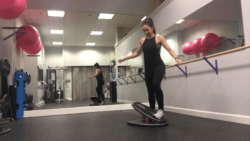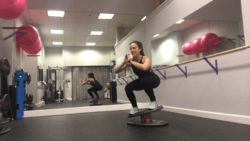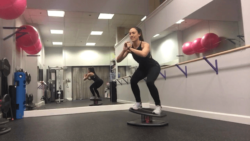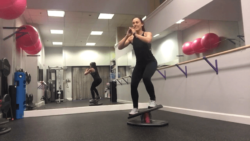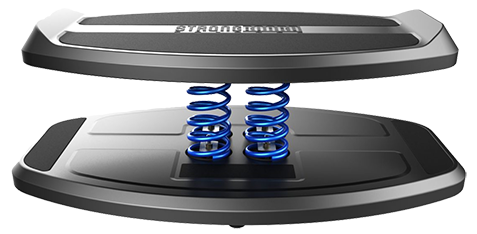This exercise is great for all core muscle groups, with key emphasis on the lower body. The static squat in combination with the teeters, creates a burn that will challenge you on a whole new level. Keeping a slight bend in your legs will help activate more lower body muscle groups. The deeper you choose to squat, the more challenging the exercise will be. Once you extend your arms out in front of you, you will help stabilize entire scapula-thoracic region, strengthen your lower back and your anterior deltoids.
- Place your left foot on platform and push down until platform touches the base. Bring your opposite foot to other side of platform and level the board to a neutral position, making sure both feet are parallel to one another, and resting against the platform handles.
- Keep your chest up, shoulders in your back pockets, and abs engaged.
- Bring your arms out in front of you as you lower yourself into a full squat (seated position with 90 degree angle). Holding this static squat position, begin to teeter the platform left to right for 30-50 repetitions.
- Bring yourself up into a half squat (45 degree angle), then hold the position static and teeter left to right for 30-50 more repetitions.
- Bring yourself up to standing position, with a slight bend in knees, and perform 30-50 more repetitions.
- Repeat steps 2-5 for desired amount of sets.
Tips: Always keep head aligned with the spine and look straight forward. Having a focal point really helps. Engage the board and hold on using your core muscles, relax your feet and toes. For more of a challenge, you can slow teeter tempo. Changing amount of teeter repetitions will also make this exercise more difficult. Still not challenging enough for you? Do it with your eyes closed.
StrongBoard Balance utilizes MULTI SPRING TECHNOLOGY™ that works with your body to deliver the perfect amount of stimulation to keep your core musculature and stabilizing muscles engaged and contracted, while training your central nervous system, improving posture, proprioception and reaction time.
